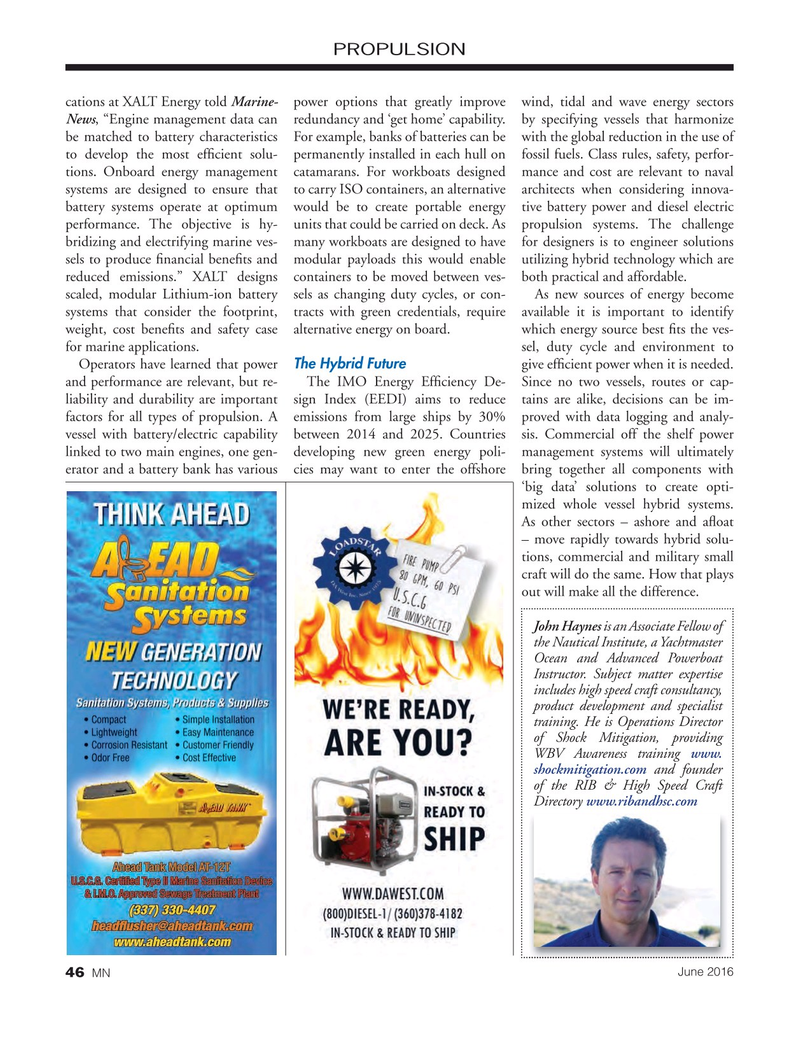
Page 46: of Marine News Magazine (June 2016)
Combat & Patrol Craft Annual
Read this page in Pdf, Flash or Html5 edition of June 2016 Marine News Magazine
PROPULSION cations at XALT Energy told Marine- power options that greatly improve wind, tidal and wave energy sectors
News, “Engine management data can redundancy and ‘get home’ capability. by specifying vessels that harmonize be matched to battery characteristics For example, banks of batteries can be with the global reduction in the use of to develop the most ef? cient solu- permanently installed in each hull on fossil fuels. Class rules, safety, perfor- tions. Onboard energy management catamarans. For workboats designed mance and cost are relevant to naval systems are designed to ensure that to carry ISO containers, an alternative architects when considering innova- battery systems operate at optimum would be to create portable energy tive battery power and diesel electric performance. The objective is hy- units that could be carried on deck. As propulsion systems. The challenge bridizing and electrifying marine ves- many workboats are designed to have for designers is to engineer solutions sels to produce ? nancial bene? ts and modular payloads this would enable utilizing hybrid technology which are reduced emissions.” XALT designs containers to be moved between ves- both practical and affordable.
scaled, modular Lithium-ion battery sels as changing duty cycles, or con- As new sources of energy become systems that consider the footprint, tracts with green credentials, require available it is important to identify weight, cost bene? ts and safety case alternative energy on board. which energy source best ? ts the ves- for marine applications. sel, duty cycle and environment to
Operators have learned that power The Hybrid Future give ef? cient power when it is needed. and performance are relevant, but re- The IMO Energy Ef? ciency De- Since no two vessels, routes or cap- liability and durability are important sign Index (EEDI) aims to reduce tains are alike, decisions can be im- factors for all types of propulsion. A emissions from large ships by 30% proved with data logging and analy- vessel with battery/electric capability between 2014 and 2025. Countries sis. Commercial off the shelf power linked to two main engines, one gen- developing new green energy poli- management systems will ultimately erator and a battery bank has various cies may want to enter the offshore bring together all components with ‘big data’ solutions to create opti- mized whole vessel hybrid systems.
As other sectors – ashore and a? oat – move rapidly towards hybrid solu- tions, commercial and military small craft will do the same. How that plays out will make all the difference.
John Haynes is an Associate Fellow of the Nautical Institute, a Yachtmaster
Ocean and Advanced Powerboat
Instructor. Subject matter expertise includes high speed craft consultancy, product development and specialist training. He is Operations Director of Shock Mitigation, providing
WBV Awareness training www.
shockmitigation.com and founder of the RIB & High Speed Craft
Directory www.ribandhsc.com
June 2016 46 MN
MN June16 Layout 32-49.indd 46 5/17/2016 10:44:43 AM

 45
45

 47
47
